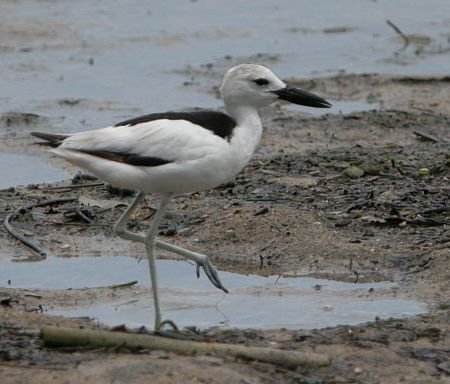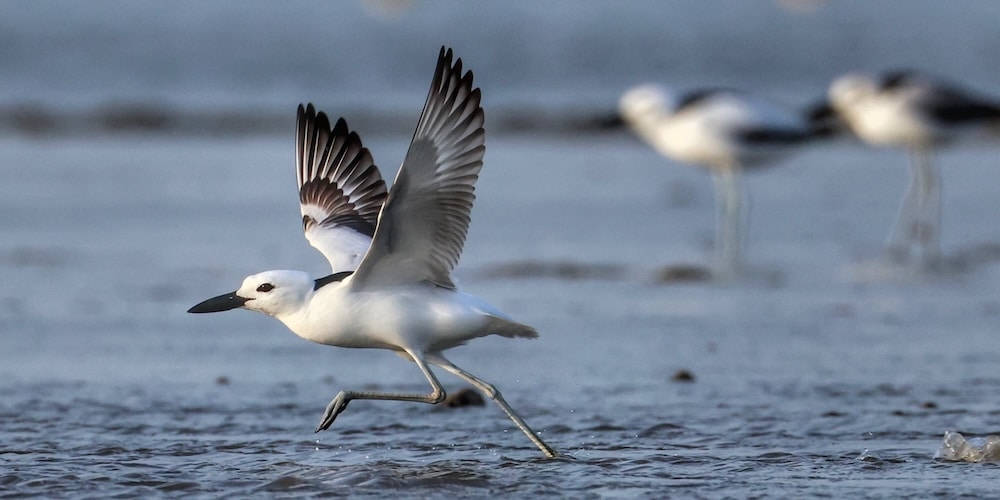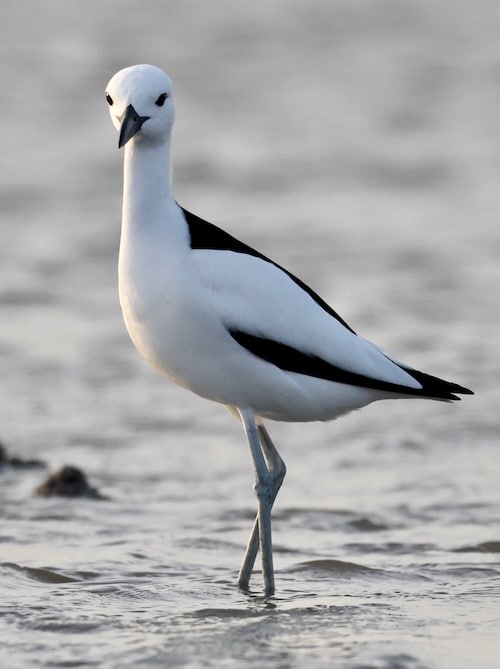Dromadidae – Crab Plover

The Dromadidae (Crab-Plover), family is related to the waders, but sufficiently distinctive to merit its own family. The order Charadriiformes also includes Pluvianellidae (Magellanic Plover), Chionidae (Sheathbills), Burhinidae (Thick-knees & Stone Curlews), Pluvianidae (Egyptian Plover), Recurvirostridae (Stilts & Avocets) Ibidorhynchidae (Ibisbill), Haematopodidae (Oystercatchers), Charadriidae (Plovers & Lapwings), Pedionomidae (Plains Wanderer), Thinocoridae (Seedsnipes), Rostratulidae (Painted Snipe), Jacanidae (Jacanas), Scolopacidae (Sandpipers), Turnicidae (Buttonquails), Glareolidae (Coursers & Pratincoles), Stercorariidae (Skuas), Alcidae (Auks) and Laridae (Gulls, Terns & Skimmers).

Crab Plover Dromas ardeola – ©Bird-Photo-Tours ASIA
The Dromadidae family relationship within the Charadriiformes is unclear, some have considered it to be closely related to the thick-knees, or the pratincoles, while others have considered it closer to the auks and gulls. It is the only member of the genus Dromas and is unique among waders in making use of ground warmth to aid incubation of the eggs.

Crab Plovers in flight – ©Bird-Photo-Tours ASIA
The Crab Plover resembles a plover, but has very long grey legs and a strong heavy black bill similar to a tern. Its black-and-white plumage and long-necked upright posture with heavy bill makes it distinctive and unmistakable. Its bill is unique among waders, and specialised for eating crabs. They also have partially webbed toes. The plumage is white except for black on its back and in the primary feathers of the wings. They are noisy birds, calling frequently on their breeding sites and in their wintering grounds. The usual call is a ‘ka’ similar to that of the Bar-tailed Godwit, but repeated rapidly. Flocks may produce a whinnying sound that rises and at in the breeding season produce whistling ‘kew-ki-ki’ notes.

Males and females are not easily distinguished, but males have a heavier and longer bill. Juveniles have black on the mantle, are greyish and remain in this plumage for a year. Flocks fly in lines or ‘V’ formations. The Crab-plover is one of the species to which the Agreement on the Conservation of African-Eurasian Migratory Waterbirds (AEWA) applies.
They are unusual for waders in that they nest in burrows in sandy banks. In the Red Sea region, the breeding season begins around the middle of May. It is a colonial breeder, nesting in colonies as large 1500 pairs. They lay one white egg, occasionally two, which are large for its body size. The nest burrow temperature is optimal due to solar radiation and the parents are able to leave the nest unattended for as long as 58 hours. The chicks are also unique for the usually nidifugous waders in being unable to walk and remain in the nest for several days after hatching, having food brought to them. Even once they fledge, they have a long period of parental care afterwards. Both males and females take care of the young.
-
Number of bird species: 1
(As at August 2025)
The Dromadidae family has just one species in one genus, which is:
Crab Plover Dromas ardeola
-
International Wader Study Group
WebsiteThe International Wader Study Group (IWSG) is an association of amateurs and professionals from all parts of the world interested in Charadrii (waders or shorebirds). Membership of the WSG is currently over 650 worldwide. Members can be found in over 50 countries around the world, including all European countries and the Americas, Asia, Africa and Australasia. The interests of the group have diversified from its original focus from ringing and migration-related studies to embrace all aspects of wader biology.
-
Waders of Europe, Asia & North America
| By Stephen Message & Don Taylor | Christopher Helm | 2006 | 224 pages, 80 plates with colour illustrations | ISBN: 9780713652901 Buy this book from NHBS.com
-
Dromadidae
Family AccountThis slender shorebird with an over-sized bill subsists on a diet dominated by crabs...
-
Cab Plover Dromas ardeola
Species AccountUtterly unmistakable large shorebird: gleaming white adult has a black back, black flight feathers, and a very heavy dark bill, which is used to dispatch... -
Crab Plover Dromas ardeola
Species AccountThis species has an extremely large range, and hence does not approach the thresholds for Vulnerable under the range size criterion (Extent of Occurrence under 20,000 km² combined with a declining or fluctuating range size, habitat extent/quality, or population size and a small number of locations or severe fragmentation). -
Crab Plover Dromas ardeola
Species AccountThe crab-plover or crab plover (Dromas ardeola) is a bird related to the waders, but sufficiently distinctive to merit its own family Dromadidae. Its relationship within the Charadriiformes is unclear, some have considered it to be closely related to the thick-knees, or the pratincoles, while others have considered it closer to the auks and gulls. It is the only member of the genus Dromas and is unique among waders in making use of ground warmth to aid incubation of the eggs... -
Crab Plover Dromas ardeola
Species AccountDromas ardeola is listed as Le -
Crab Plover Dromas ardeola
Species AccountSound archive and distribution map.
-
The New Shorebirds Handbook Project
BlogThis is a blog of The New Shorebirds Handbook Project which aims to bring together the current knowledge on shorebird science, conservation and a little bit more. By following the blog, readers could insight into the progress and important milestones of the project and the recent news on the world of waders and a bit more of us, the authors….
